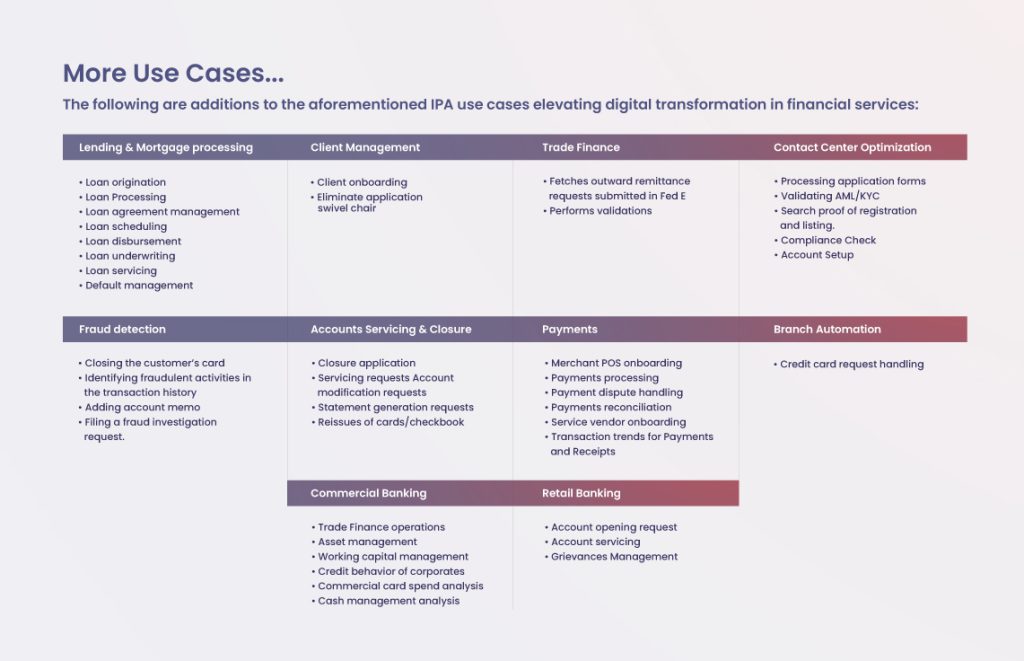
Listen to this blog
If you think your financial firm is dealing with a never-ending series of operational efficiency issues, you’re not alone. 81 percent of banking executives are overwhelmed by the rapid shift to technological disruptions. What if your processes evolve on their own and move beyond efficiency?
BFS institutions with large chunks of unstructured data coupled with conventional approaches are grappling with an increasing number of document processing and governance challenges. Streamlining big data, protecting against data breaches, delivering personalized services, and investing in up-to-date technologies, are just some of the factors concerning banking and financial executives.
Intelligent Procession Automation (IPA) leveraging the core strengths of AI, RPA, and human intelligence can help you unlock your business’s true potential via self-learning processes translating into higher productivity, ROI, and risk management.
It doesn’t end here; your business is more empowered with fully digitized processes, elevating customer relationships and unleashing new ways of innovation. That brings us to the next question — what is stopping banking and financial institutions from digitizing through automation and how can automation help the BFS sector? To respond to this, we must first fully understand —
Key Challenges Faced by BFS Institutions Driving Automation
Owing to the benefits of AI and RPA technologies, many financial institutions are taking an interest in the IPA technologies but face unprecedented challenges. Let’s take a closer look below:
Challenge 1: Changing Customer Behavior
In the post-COVID-19 era, BFSI executives cannot expect customers to revert back to the conventional channels of interaction. Becoming more digitally informed, customers now expect banks and financial institutions to offer complete transparency, more flexibility, and security, not to mention contactless payments and personalization — wanting to be understood and avail of the services on their own terms!
Challenge 2: Tightening Regulations & Controls
The number of regulations has soared in recent years. Yet, the influx of new regulatory requirements continues unabated. Global banks are subject to complying with over 120,000 pages of regulations. Even though many new regulations are broad and continually changing, banks must conform to them within tight timelines. Moreover, banking compliance officers will closely monitor current regulatory obligations along with the corresponding processes and controls.
However, when conforming to banking regulations is the focus, that’s only half the struggle. Regulations necessitate a plethora of data and paperwork from a variety of policymakers. You must be able to put the data to use by updating applicable organizational procedures, controls, and policies. Failure to do so could result in hefty fines.
Challenge 3: Scalability & Profitability
Banks and financial institutions strive to grow strategically without surpassing a sustainable pace or overstepping the organization’s risk tolerance. When it comes to M&A — integrating diverse operational systems, technologies, and workforces is a concerning factor, especially if those systems models aren’t well-documented or comprehended across the organization. Alternatively, in the case of profitability — the challenge is to transform without forsaking established lines of business and to innovate without becoming engrossed in the process.
Challenge 4: Changing Workforce Dynamics
BFSI executives are confronting tremendous difficulties in managing their workforce. Only 50% of employees in the banking sector are highly engaging, reports Quantum Workplace data, while 35% are at a retention risk.
Due to the siloed systems, processes, and technology that have long been a part of the banking and financial services sector (BFSI), many personnel struggles to manage consumer concerns. Also, studies show that employees spend over three hours every day on manual, repetitive tasks that aren’t part of their primary job, resulting in low morale, slow performance, inconsistent outcomes, and fatal errors.
Challenge 5: Thriving Fintech
Although digital transformation in financial services is accelerating, these initiatives are often sluggish, limited, and fragmented, leading to a ubiquitous and harmful “technology trap.” As a result, many banks fail to harness the full potential of their investments.
BFSI leaders must break free from the technology trap mindset because digital transformation is here to stay for the long run, and the window for change is shrinking. This is the time for banks and financial institutions to establish a clear and actionable plan.
Translation: Instead of automating a few tasks, end-to-end automation powered by technologies like RPA and Intelligent Automation should be the core priority for the BFS institutions.
How Intelligent Process Automation Helps Break Through the above Challenges
It is not news how COVID-19 became one of the most significant catalysts for digital innovation in financial services. Given the aforementioned challenges, it is not sufficient for banks to be available to their customers. Ensuring compliance, offering personalized solutions, and delivering human touch at all touchpoints are crucial factors. To obtain this, embedding RPA+IA into BFS operations is the high priority ask.
Let’s take a further look at how Intelligent Process Automation (IPA) can help businesses transform digitally while meeting the above challenges and beyond.
Scale Operational Efficiency in the Processes
Successful implementation of IPA helps businesses improve efficiency and productivity in a myriad of ways. Leading banks globally have made headlines for utilizing robotic process automation (RPA) to minimize labor costs and improve operational efficiency. Axis Bank and Deutsche Bank, in particular, received attention for deploying RPA to leverage business process automation. The various value additions of this technology make it one of the most sought-after technologies in the BFS industry.
- Streamline and automate manual processes across accounts, treasury, payments, lending, and mortgage processing using Bots — improving productivity by over 70%.
- Add speed and accuracy to complex banking operations across accounts, lending, mortgage, payments, and customer service.
- Apply M/L Models to digitize complex documents to identify and extract key data values and complete a fully intelligent automated business process.
Revitalize Customer Experience
Data is one of the most powerful elements in the digital world. This is the reason why many banks and financial institutions are switching to data and AI-enabled automation to improve all aspects of their customer journey. A notable example is Bank of America’s Erica””.
By deploying artificial intelligence-powered virtual assistants, Bank of America’s Erica grew dramatically to exceed the 7 million user-base mark in a year. Formerly providing on-the-go access to accurate information, it further extended to intelligent insights, eventually offering personalized suggestions on money management based on the user’s banking habits — resulting in a user base surge from 7 to 10 million in just a few months .
What More? IPA connects the dots between what a customer needs and what you can offer by intelligently gathering data, applying ML, and leveraging Bots to improve interactions and elevate customer service as well as engagement. A cherry on top, RPA technology automates rule-based processes to attend to user inquiries in real-time, reducing turnover times while also enhancing your decision-making capabilities and leveraging NLP to train your bots to engage with the users in a human-like manner. Also wherever require it’s very capable to bring Human In loop to manage all exceptions path’s.
Better Compliance, Improved Regulatory Reporting, and Risk Mitigation
Given the nature of its business operations, banking and financial institutions are under closer inspection and regulation lens. Intelligent Automation technology ensures the tracking of multiple regulatory changes, uses AI to identify risks and devises customized workflows enabling compliance while mitigating risks with zero errors in regulatory reporting.
The technology-agnostic RPA combines data from various legacy systems to present it in the needed format, even if the data in the systems aren’t in the same format, cutting down large chunks of data handling and time required. It safeguards the banking and financial institutions by tracking all payments in real-time and raises a red flag for probable fraud transaction patterns, minimizing response time. RPA can help prevent fraud in some circumstances by restricting accounts and halting transactions.
Furthermore, AI technology enables support in various risk assessment and reporting operations, such as preparing regulatory reports. According to McKinsey , one bank out of a slew of financial institutions saved 30% on essential finance procedures while simultaneously cutting error rates. Furthermore, by decreasing the time and effort required to complete a credit review, one was able to improve compliance by lowering operational risks and improving controls.
Improve Employee Experience
Leverage automation in hiring the best talent; automate manual tasks and free-up workforce for valuable tasks.
Employees at banks deal with a wide range of data from consumers, and legacy systems are prone to mistakes. Globally, banks are exploring RPA to reduce manual data processing and eliminate errors. Using bots to automate such laborious tasks can lower processing expenses by 30% to 70%. Banks can automate several banking processes, freeing up employees for more critical tasks.
Take, for instance, Deutsche Bank’s intelligent automation software which enables the bank to use both optical character recognition (or OCR) and machine learning technologies to automate data harvesting from masses of documents, saving millions of euros while allowing its teams to focus on more crucial tasks. The bank also employed intelligent business automation technology to speed up document custody operations.
Another successful implementation includes Bancolombia, the world’s tenth largest financial organization, automating its BPM. Hundreds of activities in customer care, credit review, clearance and settlement, and equity markets were automated by bots. The organization saved over 127 thousand hours and increased customer service effectiveness by 50 percent.

Make your Business Processes Work for you. Make them Intelligent with Visionet’s IPA
By harnessing the power of AI and RPA, banks can accomplish more with fewer resources while reaping financial rewards. Evident in several success stories and satisfied client testimonials, Visionet Systems leverages its 25+ years of domain expertise, its legacy of business process management, and globally renowned technology partnerships, including UiPath, Automation Anywhere, Power Automate, and Azure Cognitive Services, to help banks and financial services transform their complex processes, enhance CX, eliminate costly errors, and improve business efficiency with Intelligent Process Automation.
What’s Next?
In a highly regulated industry, automation is the underpinning element in improving your firm’s integrity and precision of compliance while reducing repetitive back-office processes. If you are looking for an automation partner to expedite your Intelligent Process Automation journey, maintain consistency and infallible adherence to compliance rules, and uplift banking operations, Visionet is happy to serve you. Request a demo from our experts or visit our website to learn more.




